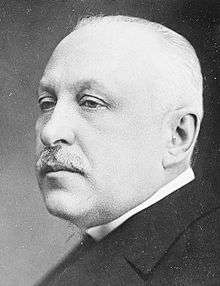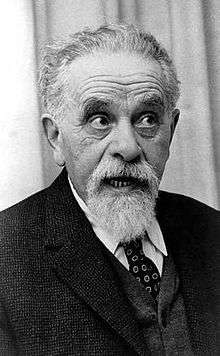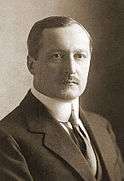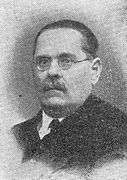Polish legislative election, 1928
| | |||||||||||||||||||||||||||||||||||||||||||||||||||||||||||||||||||||||||||||||||||||||||||||||||||||||
| |||||||||||||||||||||||||||||||||||||||||||||||||||||||||||||||||||||||||||||||||||||||||||||||||||||||
| |||||||||||||||||||||||||||||||||||||||||||||||||||||||||||||||||||||||||||||||||||||||||||||||||||||||
 |
| This article is part of a series on the politics and government of Poland |
|
|
Related topics
|
Parliamentary elections were held in Poland on 4 March 1928, with Senate elections held a week later on 11 March.[1] The Nonpartisan Bloc for Cooperation with the Government, a coalition of the Sanation faction - won the highest number of seats in the Sejm (125 out of 444) and 48 out of 111 in the Senate. Unlike latter elections during the Sanation era, opposition parties were allowed to campaign with only a few hindrances, and also gained a significant number of seats. The 1928 election is generally considered the last free election in Poland until 1989 or 1991, depending on the source.[2][3]
Background
The 1928 elections were the first elections after Józef Piłsudski's May Coup in 1926. Thirty-four parties took part in the 1928 elections.[4] Piłsudski was supported by the Nonpartisan Bloc for Cooperation with the Government (BBWR) led by Walery Sławek, which campaigned for a more authoritative government, declaring its total support for Piłsudski[5] and proclaiming itself to be a patriotic, non-partisan and pro-government formation.[2] Other factions in contemporary Polish politics and their primary parties included: the Left, consisting of the Polish Socialist Party of Ignacy Daszyński; the Communist Party, two Polish People's Party factions (the Polish People's Party "Wyzwolenie" of Jan Woźnicki and Stronnictwo Chłopskie of Jan Dąbski); the Right (endecja, represented by the Popular National Union of Stanisław Głąbiński); the Center, composed of the PSL faction, Christian Democracy of Wojciech Korfanty and the National Workers' Party of Adam Chadzyński; and finally, the Minorities, represented by the Bloc of National Minorities.[2]
The government applied much pressure to ensure victory for its candidates. Propaganda media were distributed, Sanation supporters tried to break up opposition rallies and some opposition lists and candidates were declared invalid by ostensibly neutral government institutions.[4] Pressure was put on state employees to vote for the BBWR and to participate in its electoral campaign. Public funds were diverted to the BBWR, which had ready use of government facilities.[2]
Despite these irregularities, opposition parties were still able to campaign and put forward candidates, and the results were not falsified. For these reasons, the 1928 election is reckoned as the last even partially free election held during the Second Polish Republic, and the last free elections of any sort held in Poland until 1989 (or 1991).[2][3]
Results
Sejm
| Party | Votes | % | Seats | +/– |
|---|---|---|---|---|
| Nonpartisan Bloc for Cooperation with the Government | 2,399,438 | 21.0 | 125 | New |
| Polish Socialist Party | 1,482,097 | 13.0 | 64 | +23 |
| Bloc of National Minorities | 1,439,568 | 12.6 | 55 | –11 |
| Popular National Union | 925,570 | 8.1 | 38 | – |
| Polish People's Party "Wyzwolenie" | 834,710 | 7.3 | 40 | –9 |
| Polish Catholic Bloc | 770,564 | 6.8 | 34 | – |
| Ukrainian Group | 647,198 | 5.7 | 17 | +12 |
| Peasant Party | 618,414 | 5.4 | 26 | – |
| Jewish Group | 535,933 | 4.7 | 6 | –12 |
| National Workers' Party | 228,119 | 2.0 | 11 | –7 |
| Communist Party | 217,240 | 1.9 | 5 | +3 |
| Catholic Union of Western Lands | 193,323 | 1.7 | 3 | – |
| Polish National Labour Bloc | 146,947 | 1.3 | 4 | – |
| Agrarian Union | 135,277 | 1.2 | 3 | – |
| Ruthenian | 132,018 | 1.2 | 1 | – |
| Struggle for interests of Workers and Peasants | 71,704 | 0.6 | 3 | – |
| Monarchists | 53,579 | 0.5 | 0 | – |
| Worker's Alliance | 49,230 | 0.4 | 2 | – |
| Christian Democratic Cieszyn | 46,206 | 0.4 | 1 | – |
| Radical Peasant Party | 44,560 | 0.4 | 0 | –4 |
| Belarusian Peasants and Workers | 35,076 | 0.3 | 2 | – |
| Christian Democratic Króleska Huta | 33,037 | 0.3 | 1 | – |
| Christian Democratic Katowice | 30,363 | 0.3 | 1 | – |
| Farmers Camp Białystok | 19,067 | 0.2 | 1 | – |
| Left Peasant Alliance Samopomoc | 18,100 | 0.2 | 1 | – |
| NSPP | 13,068 | 0.1 | 0 | – |
| Local lists | 361,530 | 3.1 | 0 | – |
| Invalid/blank votes | 349,939 | – | – | – |
| Total | 11,831,875 | 100 | 444 | 0 |
| Registered voters/turnout | 14,979,853 | 79.0 | – | – |
| Source: Nohlen & Stöver | ||||
Senate
| Party | Votes | % | Seats | +/– |
|---|---|---|---|---|
| Nonpartisan Bloc for Cooperation with the Government | 1,844,393 | 28.8 | 48 | – |
| Bloc of National Minorities | 1,065,455 | 16.7 | 21 | –2 |
| Polish Socialist Party | 715,556 | 11.2 | 10 | +3 |
| Popular National Union | 590,142 | 9.2 | 9 | – |
| Polish Catholic Bloc | 426,060 | 6.7 | 6 | – |
| Polish People's Party "Wyzwolenie" | 391,918 | 6.1 | 7 | –1 |
| Ukrainian Group | 228,969 | 3.6 | 2 | – |
| Stronnictwo Chłopskie | 276,489 | 4.3 | 3 | – |
| Jewish Group | 218,435 | 3.4 | 1 | –3 |
| National Workers' Party | 143,806 | 2.2 | 2 | –1 |
| Polish National Labour Bloc | 132,276 | 2.1 | 1 | –1 |
| Polish Christian Democratic Party | 67,220 | 1.1 | 1 | – |
| Communist Party | 48,352 | 0.8 | 0 | 0 |
| Ruska | 38,778 | 0.6 | 0 | – |
| Agrarian Union | 36,118 | 0.6 | 0 | – |
| Katolicka Unia Ziem Zachodnich | 12,753 | 0.2 | 0 | – |
| Radical Peasant Party | 6,422 | 0.1 | 0 | 0 |
| Monarchists | 4,657 | 0.1 | 0 | – |
| Local lists | 150,745 | 2.4 | 0 | – |
| Invalid/blank votes | 116,960 | – | – | – |
| Total | 6,515,504 | 100 | 111 | 0 |
| Registered voters/turnout | 10,182,345 | 64.0 | – | – |
| Source: Nohlen & Stöver | ||||
Aftermath
The BBWR government bloc won the highest number of seats (125 out of 444 in Sejm (Polish parliament) - 28.12% of the total, and 48 out of 111 in the Senate of Poland - 43.24% of the total); the opposition parties, however, gained a majority of the remaining seats,[6] with the left - including Polish Communists - doing much better than the traditional Polish Right.[4] Groth notes that the elections showed a progressively increasing fragmentation of the Polish electorate; a steady and significant increase in the proportion of ethnic minority voting; the rapid rise of the Polish Socialist Party as a major force within the far less stable and cohesive Polish Left; and the substantial weakening of the Right by Piłsudski's supporters, as the BBWR, despite its claims of being above traditional party divisions in fact attracted support mostly from the Right.[2]
Although the opposition to Sanation failed to gain control of the Sejm, it was able to show its strength and prevent Sanation from taking control of the Sejm. This convinced Piłsudski and his supporters that more drastic measures had to be taken in dealing with the opposition. Opposition politicians became increasingly persecuted and threatened.[5]
Opposition parties formed the Centrolew coalition to oppose the government of Sanation. Their actions led to a vote of no confidence for the Sanation government and dissolution of the parliament. New elections were held in 1930; however, the Sanation succeeded in having many Centrolew politicians arrested; and the 1930 elections are not considered free.[5]
References
- ↑ Nohlen, D & Stöver, P (2010) Elections in Europe: A data handbook, p1491 ISBN 978-3-8329-5609-7
- 1 2 3 4 5 6 A. J. Groth, Polish Elections 1919-1928, Slavic Review, Vol. 24, No. 4. (Dec., 1965), pp. 653-665. JSTOR, Last accessed on 14 April 2007
- 1 2 Kenneth Ka-Lok Chan, Poland at the Crossroads: The 1993 General Election, Europe-Asia Studies, Vol. 47, No. 1. (1995), pp. 123-145. JSTOR, Last accessed on 14 April 2007
- 1 2 3 TIME article on 1928 Polish elections from Mar. 19, 1928 Last accessed on 14 April 2007
- 1 2 3 (Polish) Bartłomiej Kozłowski, Aresztowanie przywódców Centrolewu Archived January 18, 2007, at the Wayback Machine., Last accessed on 14 April 2007
- ↑ The Elections to the Polish Parliament (Sejm) 1928 - results
Further reading
- A. J. Groth, Polish Elections 1919-1928, Slavic Review, Vol. 24, No. 4 (Dec., 1965), pp. 653–665 JSTOR




